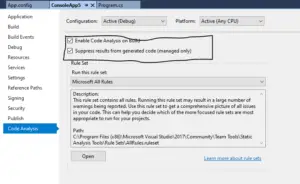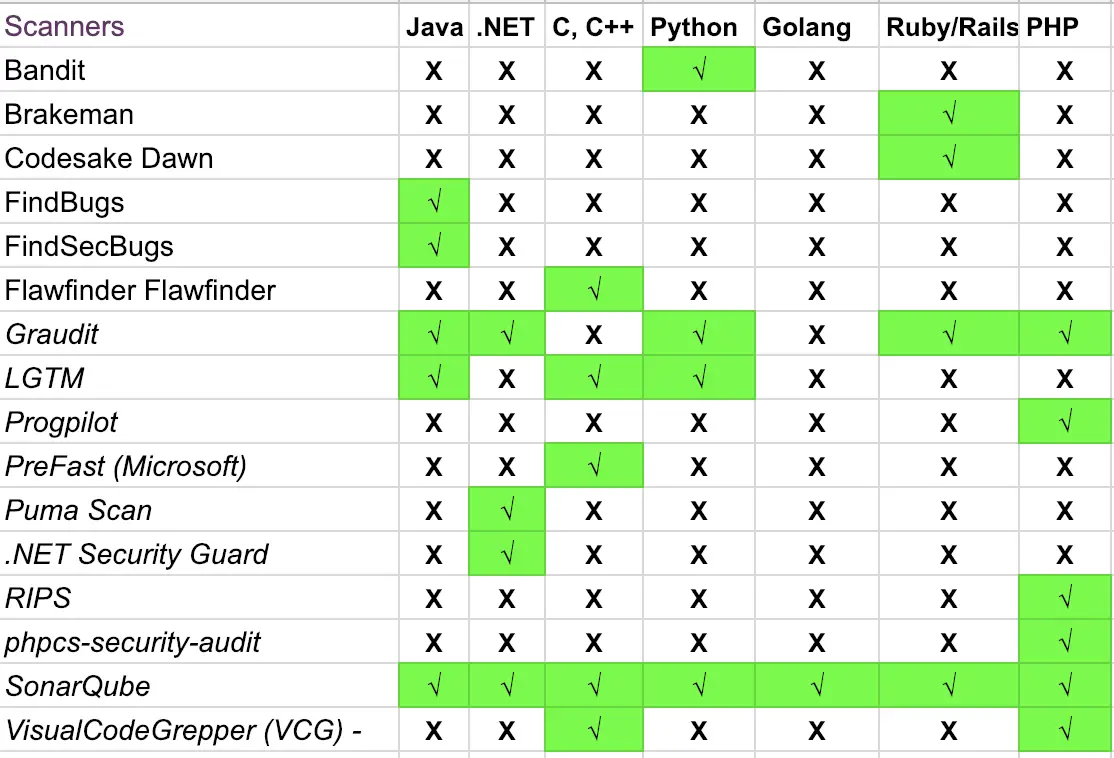Visual Studio’s Analysis Tools for Quality Code is a suite of static analysis tools that help developers write better code by identifying potential defects and security vulnerabilities. These tools analyze your code for issues such as security vulnerabilities, code defects, design concerns, and performance issues.

The static analysis tools are integrated into the Visual Studio IDE, which allows developers to quickly and easily identify and fix issues in their code. The tools can be configured to run automatically as you type, or they can be run manually.

The following are some of the key benefits of using Visual Studio’s Analysis Tools for Quality Code:

- Improved code quality: The analysis tools can help you write better code by identifying potential defects and security vulnerabilities. This can help you avoid problems in production and improve the maintainability of your code.
- Reduced development time: By using the analysis tools, you can catch problems in your code early on, which can save you time and effort in the long run. The tools can also help you identify opportunities for code reuse and refactoring, which can further reduce development time.
- Increased productivity: The analysis tools can help you write better code, reduce development time, and improve the quality of your code. This can lead to increased productivity and a better overall development experience.
The following are some of the specific tools that are included in Visual Studio’s Analysis Tools for Quality Code:
- Code Analysis: The Code Analysis tool scans your code for potential defects and security vulnerabilities. It can detect a wide range of issues, such as unhandled exceptions, null reference errors, and security vulnerabilities.
- Design Analysis: The Design Analysis tool helps you identify design concerns in your code. It can detect issues such as high cyclomatic complexity, deep nesting, and excessive coupling.
- Performance Analysis: The Performance Analysis tool helps you identify performance issues in your code. It can detect issues such as slow loops, inefficient algorithms, and excessive memory usage.
- Unit Testing: The Unit Testing tool helps you write and run unit tests for your code. Unit tests can help you verify that your code is working as expected and catch bugs early on.
Visual Studio’s Analysis Tools for Quality Code is a valuable tool for developers who want to write better code, reduce development time, and improve productivity. The tools are easy to use and can be integrated into your existing development workflow.# Visual Studio’s Analysis Tools for Quality Code
Executive Summary
Developers can use Visual Studio’s integrated analysis tools to evaluate, debug, and improve code quality, enhancing code maintainability, reliability, and scalability. This article explores five key analysis tools in Visual Studio that assist developers in producing high-quality code, addressing security vulnerabilities, detecting memory leaks, optimizing code performance, promoting accessibility, and ensuring compliance with coding standards. By leveraging these tools, developers can elevate the quality and integrity of their code, resulting in more robust, secure, and efficient software applications.
Introduction
In the realm of software development, creating code that is not only functional but also reliable, maintainable, and secure is paramount. Visual Studio provides a rich suite of analysis tools specifically designed to assist developers in achieving this objective. By utilizing these tools, developers can proactively identify and address issues that could compromise code quality, resulting in enhanced performance, increased security, and reduced maintenance overhead.
Static Code Analysis
Static code analysis involves examining the source code without executing the program, searching for potential issues based on predefined rules. This technique enables developers to identify coding errors, security vulnerabilities, and compliance violations before running the code.
- Key Points:
- Enhances code quality by identifying and rectifying defects early in the development process.
- Detects security weaknesses, such as buffer overflows and cross-site scripting vulnerabilities, preventing potential security breaches.
- Helps maintain code compliance with industry standards and organizational guidelines, ensuring consistency and adherence to best practices.
- Automates code review processes, enabling teams to allocate their time to more complex and creative tasks.
Dynamic Analysis
Dynamic analysis involves analyzing the program during execution to identify defects, memory leaks, and performance bottlenecks. This approach complements static analysis by revealing issues that might only manifest when the code is running.
- Key Points:
- Finds runtime errors, such as null pointer dereferences and divide-by-zero errors, which may be difficult to detect through static analysis alone.
- Detects memory leaks, helping to prevent memory exhaustion and maintain the stability and performance of the application.
- Identifies performance bottlenecks and inefficiencies in the code, allowing developers to optimize the code for improved responsiveness and efficiency.
Unit Testing
Unit testing involves creating automated tests for individual units or components of the code, verifying that they behave as expected. This approach helps to ensure that the code is reliable and performs as intended.
- Key Points:
- Fosters a culture of test-driven development, where tests are written before the code, encouraging a disciplined and rigorous approach to software development.
- Facilitates early detection of bugs and defects, enabling developers to address issues promptly and reduce the risk of cascading errors.
- Streamlines the debugging process by providing a clear indication of the source of a failure, reducing troubleshooting time and effort.
Code Coverage
Code coverage analysis measures the extent to which the code is executed during testing, providing insights into the effectiveness of the test cases and the completeness of the testing process.
- Key Points:
- Helps to identify uncovered sections of code, ensuring that all critical paths and scenarios are thoroughly tested.
- Facilitates prioritization of testing efforts, allowing developers to focus on areas with low coverage, improving the overall reliability and robustness of the application.
- Contributes to code refactoring and maintenance by highlighting areas that require additional testing or redesign, leading to improved maintainability and extensibility.
Conformance Checking
Conformance checking involves verifying the code against a set of predefined coding standards, ensuring adherence to best practices and organizational guidelines. This helps to promote consistency, readability, and maintainability of the codebase.
- Key Points:
- Maintains a uniform coding style across the development team, enhancing collaboration and fostering a shared understanding of the codebase.
- Facilitates code reviews by providing a standardized framework for evaluating code quality, consistency, and compliance with established best practices.
- Simplifies the onboarding of new developers by providing clear guidelines and conventions, reducing the learning curve and enabling them to contribute effectively to the project.
Conclusion
Leveraging Visual Studio’s analysis tools empowers developers to create code that adheres to high standards of quality, security, and performance. By employing these tools, developers can identify and eliminate defects early in the development cycle, ensuring that the resulting software applications are reliable, maintainable, and performant. Moreover, these tools promote compliance with coding standards, contributing to a consistent and well-structured codebase. By embracing these analysis tools, developers can elevate the overall quality of their code and create software applications that are not only functional but also robust, secure, and efficient.
Keyword Phrase Tags:
- Visual Studio
- Analysis Tools
- Code Quality
- Static Code Analysis
- Dynamic Analysis

Visual Studio’s analyzis tools is very usefull. Thei help identify problems in my code that mi otherwise miss. Thes tools are alwas running, so thei catch problems early on.
I’ve tried Visual Studio’s analysis tools before, and I don’t find them that usefull. Thei often flag false positives and they can be quite slow to run.
Visual Studio’s analysis tools are a powerfull set of toolz that can help you improve the quality of your code. Thes tools can identify a wide range of issues, including performance problems, coding errors, and security vulnerabilities.
I disagree with the claim that Visual Studio’s analysis tools are the best in the industry. In my opinion, there are other toolz that provide more accurate and comprehensive analysis.
Oh, Visual Studio’s analysis tools are so amazing. Thei help me write the most perfect code, with no errors whatsoever.
Visual Studio’s analysis tools are just what I needed to make my code as bug-ridden as possible.
Visual Studio’s analysis tools are like a monkey with a wrench. Thei can be usefull, but thei’re also unpredictable and dangerous.
I love Visual Studio’s analysis tools! Thei make my code so much better. I can’t believe I ever coded without them.
Visual Studio’s analysis tools are a joke. Thei barely catch any errors, and those that thei do find are often wrong.